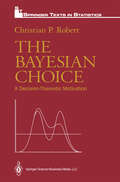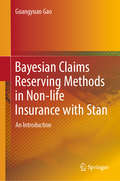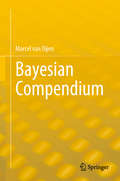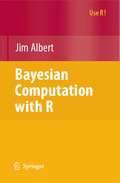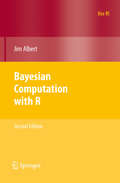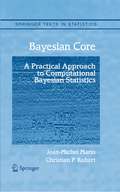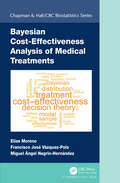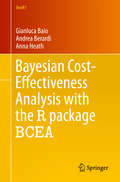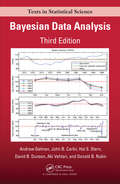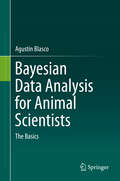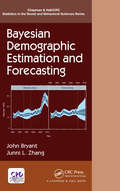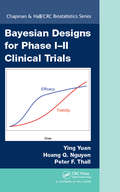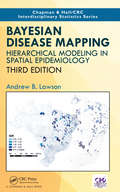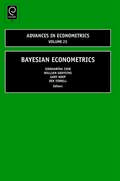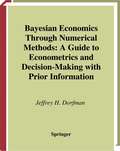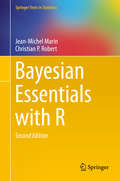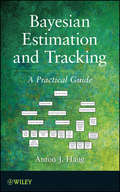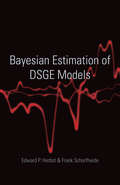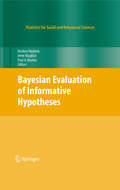- Table View
- List View
The Bayesian Choice: A Decision-Theoretic Motivation (Springer Texts in Statistics)
by Christian P. RobertThis graduate-level textbook covers both the basic ideas of statistical theory, and also some of the more modern and advanced topics of Bayesian statistics, such as complete class theorems, the Stein effect, hierarchical and empirical Bayes modelling, Monte Carlo integration, and Gibbs sampling. In translating the book from the original French, the author has taken the opportunity to add and update material, and to include many problems and exercises for students.
Bayesian Claims Reserving Methods in Non-life Insurance with Stan: An Introduction
by Guangyuan GaoThis book first provides a review of various aspects of Bayesian statistics. It then investigates three types of claims reserving models in the Bayesian framework: chain ladder models, basis expansion models involving a tail factor, and multivariate copula models. For the Bayesian inferential methods, this book largely relies on Stan, a specialized software environment which applies Hamiltonian Monte Carlo method and variational Bayes.
Bayesian Compendium
by Marcel van OijenThis book describes how Bayesian methods work. Its primary aim is to demystify them, and to show readers: Bayesian thinking isn’t difficult and can be used in virtually every kind of research. In addition to revealing the underlying simplicity of statistical methods, the book explains how to parameterise and compare models while accounting for uncertainties in data, model parameters and model structures. How exactly should data be used in modelling? The literature offers a bewildering variety of techniques and approaches (Bayesian calibration, data assimilation, Kalman filtering, model-data fusion, etc). This book provides a short and easy guide to all of these and more. It was written from a unifying Bayesian perspective, which reveals how the multitude of techniques and approaches are in fact all related to one another. Basic notions from probability theory are introduced. Executable code examples are included to enhance the book’s practical use for scientific modellers, and all code is available online as well.
Bayesian Computation with R (Use R!)
by Jim AlbertBayesian Computation with R introduces Bayesian modeling by the use of computation using the R language. Early chapters present the basic tenets of Bayesian thinking by use of familiar one and two-parameter inferential problems. Bayesian computational methods such as Laplace's method, rejection sampling, and the SIR algorithm are illustrated in the context of a random effects model. The construction and implementation of Markov Chain Monte Carlo (MCMC) methods is introduced. These simulation-based algorithms are implemented for a variety of Bayesian applications such as normal and binary response regression, hierarchical modeling, order-restricted inference, and robust modeling.
Bayesian Computation with R (Use R!)
by Jim AlbertThere has been dramatic growth in the development and application of Bayesian inference in statistics. Berger (2000) documents the increase in Bayesian activity by the number of published research articles, the number of books,andtheextensivenumberofapplicationsofBayesianarticlesinapplied disciplines such as science and engineering. One reason for the dramatic growth in Bayesian modeling is the availab- ity of computational algorithms to compute the range of integrals that are necessary in a Bayesian posterior analysis. Due to the speed of modern c- puters, it is now possible to use the Bayesian paradigm to ?t very complex models that cannot be ?t by alternative frequentist methods. To ?t Bayesian models, one needs a statistical computing environment. This environment should be such that one can: write short scripts to de?ne a Bayesian model use or write functions to summarize a posterior distribution use functions to simulate from the posterior distribution construct graphs to illustrate the posterior inference An environment that meets these requirements is the R system. R provides a wide range of functions for data manipulation, calculation, and graphical d- plays. Moreover, it includes a well-developed, simple programming language that users can extend by adding new functions. Many such extensions of the language in the form of packages are easily downloadable from the Comp- hensive R Archive Network (CRAN).
Bayesian Core: A Practical Approach to Computational Bayesian Statistics (Springer Texts in Statistics)
by Jean-Michel Marin Christian RobertThis Bayesian modeling book is intended for practitioners and applied statisticians looking for a self-contained entry to computational Bayesian statistics. Focusing on standard statistical models and backed up by discussed real datasets available from the book website, it provides an operational methodology for conducting Bayesian inference, rather than focusing on its theoretical justifications. Special attention is paid to the derivation of prior distributions in each case and specific reference solutions are given for each of the models. Similarly, computational details are worked out to lead the reader towards an effective programming of the methods given in the book.
Bayesian Cost-Effectiveness Analysis of Medical Treatments (Chapman & Hall/CRC Biostatistics Series)
by Elias Moreno Francisco Jose Vazquez-Polo Miguel Angel Negrín-HernándezCost-effectiveness analysis is becoming an increasingly important tool for decision making in the health systems. Cost-Effectiveness of Medical Treatments formulates the cost-effectiveness analysis as a statistical decision problem, identifies the sources of uncertainty of the problem, and gives an overview of the frequentist and Bayesian statistical approaches for decision making. Basic notions on decision theory such as space of decisions, space of nature, utility function of a decision and optimal decisions, are explained in detail using easy to read mathematics. Features Focuses on cost-effectiveness analysis as a statistical decision problem and applies the well-established optimal statistical decision methodology. Discusses utility functions for cost-effectiveness analysis. Enlarges the class of models typically used in cost-effectiveness analysis with the incorporation of linear models to account for covariates of the patients. This permits the formulation of the group (or subgroup) theory. Provides Bayesian procedures to account for model uncertainty in variable selection for linear models and in clustering for models for heterogeneous data. Model uncertainty in cost-effectiveness analysis has not been considered in the literature. Illustrates examples with real data. In order to facilitate the practical implementation of real datasets, provides the codes in Mathematica for the proposed methodology. The motivation for the book is to make the achievements in cost-effectiveness analysis accessible to health providers, who need to make optimal decisions, to the practitioners and to the students of health sciences. Elías Moreno is Professor of Statistics and Operational Research at the University of Granada, Spain, Corresponding Member of the Royal Academy of Sciences of Spain, and elect member of ISI. Francisco José Vázquez-Polo is Professor of Mathematics and Bayesian Methods at the University of Las Palmas de Gran Canaria, and Head of the Department of Quantitative Methods. Miguel Ángel Negrín is Senior Lecturer in the Department of Quantitative Methods at the ULPGC. His main research topics are Bayesian methods applied to Health Economics, economic evaluation and cost-effectiveness analysis, meta-analysis and equity in the provision of healthcare services.
Bayesian Cost-Effectiveness Analysis of Medical Treatments (Chapman & Hall/CRC Biostatistics Series)
by Elias Moreno Francisco Jose Vazquez-Polo Miguel Angel Negrín-HernándezCost-effectiveness analysis is becoming an increasingly important tool for decision making in the health systems. Cost-Effectiveness of Medical Treatments formulates the cost-effectiveness analysis as a statistical decision problem, identifies the sources of uncertainty of the problem, and gives an overview of the frequentist and Bayesian statistical approaches for decision making. Basic notions on decision theory such as space of decisions, space of nature, utility function of a decision and optimal decisions, are explained in detail using easy to read mathematics. Features Focuses on cost-effectiveness analysis as a statistical decision problem and applies the well-established optimal statistical decision methodology. Discusses utility functions for cost-effectiveness analysis. Enlarges the class of models typically used in cost-effectiveness analysis with the incorporation of linear models to account for covariates of the patients. This permits the formulation of the group (or subgroup) theory. Provides Bayesian procedures to account for model uncertainty in variable selection for linear models and in clustering for models for heterogeneous data. Model uncertainty in cost-effectiveness analysis has not been considered in the literature. Illustrates examples with real data. In order to facilitate the practical implementation of real datasets, provides the codes in Mathematica for the proposed methodology. The motivation for the book is to make the achievements in cost-effectiveness analysis accessible to health providers, who need to make optimal decisions, to the practitioners and to the students of health sciences. Elías Moreno is Professor of Statistics and Operational Research at the University of Granada, Spain, Corresponding Member of the Royal Academy of Sciences of Spain, and elect member of ISI. Francisco José Vázquez-Polo is Professor of Mathematics and Bayesian Methods at the University of Las Palmas de Gran Canaria, and Head of the Department of Quantitative Methods. Miguel Ángel Negrín is Senior Lecturer in the Department of Quantitative Methods at the ULPGC. His main research topics are Bayesian methods applied to Health Economics, economic evaluation and cost-effectiveness analysis, meta-analysis and equity in the provision of healthcare services.
Bayesian Cost-Effectiveness Analysis with the R package BCEA (Use R!)
by Gianluca Baio Andrea Berardi Anna HeathThe book provides a description of the process of health economic evaluation and modelling for cost-effectiveness analysis, particularly from the perspective of a Bayesian statistical approach. Some relevant theory and introductory concepts are presented using practical examples and two running case studies. The book also describes in detail how to perform health economic evaluations using the R package BCEA (Bayesian Cost-Effectiveness Analysis). BCEA can be used to post-process the results of a Bayesian cost-effectiveness model and perform advanced analyses producing standardised and highly customisable outputs. It presents all the features of the package, including its many functions and their practical application, as well as its user-friendly web interface. The book is a valuable resource for statisticians and practitioners working in the field of health economics wanting to simplify and standardise their workflow, for example in the preparation of dossiers in support of marketing authorisation, or academic and scientific publications.
Bayesian Data Analysis (Chapman And Hall/crc Texts In Statistical Science Ser.)
by Andrew Gelman John B. Carlin Hal S. Stern David B. Dunson Aki Vehtari Donald B. RubinWinner of the 2016 De Groot Prize from the International Society for Bayesian AnalysisNow in its third edition, this classic book is widely considered the leading text on Bayesian methods, lauded for its accessible, practical approach to analyzing data and solving research problems. Bayesian Data Analysis, Third Edition continues to take an applied
Bayesian Data Analysis for Animal Scientists: The Basics
by Agustín BlascoIn this book, we provide an easy introduction to Bayesian inference using MCMC techniques, making most topics intuitively reasonable and deriving to appendixes the more complicated matters. The biologist or the agricultural researcher does not normally have a background in Bayesian statistics, having difficulties in following the technical books introducing Bayesian techniques. The difficulties arise from the way of making inferences, which is completely different in the Bayesian school, and from the difficulties in understanding complicated matters such as the MCMC numerical methods. We compare both schools, classic and Bayesian, underlying the advantages of Bayesian solutions, and proposing inferences based in relevant differences, guaranteed values, probabilities of similitude or the use of ratios. We also give a scope of complex problems that can be solved using Bayesian statistics, and we end the book explaining the difficulties associated to model choice and the use of small samples. The book has a practical orientation and uses simple models to introduce the reader in this increasingly popular school of inference.
Bayesian Demographic Estimation and Forecasting (Chapman & Hall/CRC Statistics in the Social and Behavioral Sciences)
by John Bryant Junni L. ZhangBayesian Demographic Estimation and Forecasting presents three statistical frameworks for modern demographic estimation and forecasting. The frameworks draw on recent advances in statistical methodology to provide new tools for tackling challenges such as disaggregation, measurement error, missing data, and combining multiple data sources. The methods apply to single demographic series, or to entire demographic systems. The methods unify estimation and forecasting, and yield detailed measures of uncertainty. The book assumes minimal knowledge of statistics, and no previous knowledge of demography. The authors have developed a set of R packages implementing the methods. Data and code for all applications in the book are available on www.bdef-book.com. "This book will be welcome for the scientific community of forecasters…as it presents a new approach which has already given important results and which, in my opinion, will increase its importance in the future." ~Daniel Courgeau, Institut national d'études démographiques
Bayesian Demographic Estimation and Forecasting (Chapman & Hall/CRC Statistics in the Social and Behavioral Sciences)
by John Bryant Junni L. ZhangBayesian Demographic Estimation and Forecasting presents three statistical frameworks for modern demographic estimation and forecasting. The frameworks draw on recent advances in statistical methodology to provide new tools for tackling challenges such as disaggregation, measurement error, missing data, and combining multiple data sources. The methods apply to single demographic series, or to entire demographic systems. The methods unify estimation and forecasting, and yield detailed measures of uncertainty. The book assumes minimal knowledge of statistics, and no previous knowledge of demography. The authors have developed a set of R packages implementing the methods. Data and code for all applications in the book are available on www.bdef-book.com. "This book will be welcome for the scientific community of forecasters…as it presents a new approach which has already given important results and which, in my opinion, will increase its importance in the future." ~Daniel Courgeau, Institut national d'études démographiques
Bayesian Designs for Phase I-II Clinical Trials (Chapman & Hall/CRC Biostatistics Series)
by Ying Yuan Hoang Q. Nguyen Peter F. ThallReliably optimizing a new treatment in humans is a critical first step in clinical evaluation since choosing a suboptimal dose or schedule may lead to failure in later trials. At the same time, if promising preclinical results do not translate into a real treatment advance, it is important to determine this quickly and terminate the clinical evaluation process to avoid wasting resources. Bayesian Designs for Phase I–II Clinical Trials describes how phase I–II designs can serve as a bridge or protective barrier between preclinical studies and large confirmatory clinical trials. It illustrates many of the severe drawbacks with conventional methods used for early-phase clinical trials and presents numerous Bayesian designs for human clinical trials of new experimental treatment regimes.Written by research leaders from the University of Texas MD Anderson Cancer Center, this book shows how Bayesian designs for early-phase clinical trials can explore, refine, and optimize new experimental treatments. It emphasizes the importance of basing decisions on both efficacy and toxicity.
Bayesian Designs for Phase I-II Clinical Trials (Chapman & Hall/CRC Biostatistics Series #92)
by Ying Yuan Hoang Q. Nguyen Peter F. ThallReliably optimizing a new treatment in humans is a critical first step in clinical evaluation since choosing a suboptimal dose or schedule may lead to failure in later trials. At the same time, if promising preclinical results do not translate into a real treatment advance, it is important to determine this quickly and terminate the clinical evaluation process to avoid wasting resources. Bayesian Designs for Phase I–II Clinical Trials describes how phase I–II designs can serve as a bridge or protective barrier between preclinical studies and large confirmatory clinical trials. It illustrates many of the severe drawbacks with conventional methods used for early-phase clinical trials and presents numerous Bayesian designs for human clinical trials of new experimental treatment regimes.Written by research leaders from the University of Texas MD Anderson Cancer Center, this book shows how Bayesian designs for early-phase clinical trials can explore, refine, and optimize new experimental treatments. It emphasizes the importance of basing decisions on both efficacy and toxicity.
Bayesian Disease Mapping: Hierarchical Modeling in Spatial Epidemiology, Third Edition (Chapman & Hall/CRC Interdisciplinary Statistics #32)
by Andrew B. LawsonSince the publication of the second edition, many new Bayesian tools and methods have been developed for space-time data analysis, the predictive modeling of health outcomes, and other spatial biostatistical areas. Exploring these new developments, Bayesian Disease Mapping: Hierarchical Modeling in Spatial Epidemiology, Third Edition provides an up-to-date, cohesive account of the full range of Bayesian disease mapping methods and applications. In addition to the new material, the book also covers more conventional areas such as relative risk estimation, clustering, spatial survival analysis, and longitudinal analysis. After an introduction to Bayesian inference, computation, and model assessment, the text focuses on important themes, including disease map reconstruction, cluster detection, regression and ecological analysis, putative hazard modeling, analysis of multiple scales and multiple diseases, spatial survival and longitudinal studies, spatiotemporal methods, and map surveillance. It shows how Bayesian disease mapping can yield significant insights into georeferenced health data. The target audience for this text is public health specialists, epidemiologists, and biostatisticians who need to work with geo-referenced health data.
Bayesian Disease Mapping: Hierarchical Modeling in Spatial Epidemiology, Third Edition (Chapman & Hall/CRC Interdisciplinary Statistics)
by Andrew B. LawsonSince the publication of the second edition, many new Bayesian tools and methods have been developed for space-time data analysis, the predictive modeling of health outcomes, and other spatial biostatistical areas. Exploring these new developments, Bayesian Disease Mapping: Hierarchical Modeling in Spatial Epidemiology, Third Edition provides an up-to-date, cohesive account of the full range of Bayesian disease mapping methods and applications. In addition to the new material, the book also covers more conventional areas such as relative risk estimation, clustering, spatial survival analysis, and longitudinal analysis. After an introduction to Bayesian inference, computation, and model assessment, the text focuses on important themes, including disease map reconstruction, cluster detection, regression and ecological analysis, putative hazard modeling, analysis of multiple scales and multiple diseases, spatial survival and longitudinal studies, spatiotemporal methods, and map surveillance. It shows how Bayesian disease mapping can yield significant insights into georeferenced health data. The target audience for this text is public health specialists, epidemiologists, and biostatisticians who need to work with geo-referenced health data.
Bayesian Econometrics (Advances in Econometrics #23)
by Siddhartha Chib William Griffiths"Bayesian Econometrics" illustrates the scope and diversity of modern applications, reviews some recent advances, and highlights many desirable aspects of inference and computations. It begins with an historical overview by Arnold Zellner who describes key contributions to development and makes predictions for future directions. In the second paper, Giordani and Kohn makes suggestions for improving Markov chain Monte Carlo computational strategies. The remainder of the book is categorized according to microeconometric and time-series modeling. Models considered include an endogenous selection ordered probit model, a censored treatment-response model, equilibrium job search models and various other types. These are used to study a variety of applications for example dental insurance and care, educational attainment, voter opinions and the marketing share of various brands and an aggregate cross-section production function. Models and topics considered include the potential problem of improper posterior densities in a variety of dynamic models, selection and averaging for forecasting with vector autoregressions, a consumption capital-asset pricing model and various others. Applications involve U.S. macroeconomic variables, exchange rates, an investigation of purchasing power parity, data from London Metals Exchange, international automobile production data, and data from the Asian stock market.
Bayesian Economics Through Numerical Methods: A Guide to Econometrics and Decision-Making with Prior Information
by Jeffrey H. DorfmanProviding researchers in economics, finance, and statistics with an up-to-date introduction to applying Bayesian techniques to empirical studies, this book covers the full range of the new numerical techniques which have been developed over the last thirty years. Notably, these are: Monte Carlo sampling, antithetic replication, importance sampling, and Gibbs sampling. The author covers both advances in theory and modern approaches to numerical and applied problems, and includes applications drawn from a variety of different fields within economics, while also providing a quick overview of the underlying statistical ideas of Bayesian thought. The result is a book which presents a roadmap of applied economic questions that can now be addressed empirically with Bayesian methods. Consequently, many researchers will find this a readily readable survey of this growing topic.
Bayesian Essentials with R (Springer Texts in Statistics)
by Jean-Michel Marin Christian P. RobertThis Bayesian modeling book provides a self-contained entry to computational Bayesian statistics. Focusing on the most standard statistical models and backed up by real datasets and an all-inclusive R (CRAN) package called bayess, the book provides an operational methodology for conducting Bayesian inference, rather than focusing on its theoretical and philosophical justifications. Readers are empowered to participate in the real-life data analysis situations depicted here from the beginning. Special attention is paid to the derivation of prior distributions in each case and specific reference solutions are given for each of the models. Similarly, computational details are worked out to lead the reader towards an effective programming of the methods given in the book. In particular, all R codes are discussed with enough detail to make them readily understandable and expandable. Bayesian Essentials with R can be used as a textbook at both undergraduate and graduate levels. It is particularly useful with students in professional degree programs and scientists to analyze data the Bayesian way. The text will also enhance introductory courses on Bayesian statistics. Prerequisites for the book are an undergraduate background in probability and statistics, if not in Bayesian statistics.
Bayesian Estimation and Tracking: A Practical Guide
by Anton J. HaugA practical approach to estimating and tracking dynamic systems in real-worl applications Much of the literature on performing estimation for non-Gaussian systems is short on practical methodology, while Gaussian methods often lack a cohesive derivation. Bayesian Estimation and Tracking addresses the gap in the field on both accounts, providing readers with a comprehensive overview of methods for estimating both linear and nonlinear dynamic systems driven by Gaussian and non-Gaussian noices. Featuring a unified approach to Bayesian estimation and tracking, the book emphasizes the derivation of all tracking algorithms within a Bayesian framework and describes effective numerical methods for evaluating density-weighted integrals, including linear and nonlinear Kalman filters for Gaussian-weighted integrals and particle filters for non-Gaussian cases. The author first emphasizes detailed derivations from first principles of eeach estimation method and goes on to use illustrative and detailed step-by-step instructions for each method that makes coding of the tracking filter simple and easy to understand. Case studies are employed to showcase applications of the discussed topics. In addition, the book supplies block diagrams for each algorithm, allowing readers to develop their own MATLAB® toolbox of estimation methods. Bayesian Estimation and Tracking is an excellent book for courses on estimation and tracking methods at the graduate level. The book also serves as a valuable reference for research scientists, mathematicians, and engineers seeking a deeper understanding of the topics.
Bayesian Estimation and Tracking: A Practical Guide
by Anton J. HaugA practical approach to estimating and tracking dynamic systems in real-worl applications Much of the literature on performing estimation for non-Gaussian systems is short on practical methodology, while Gaussian methods often lack a cohesive derivation. Bayesian Estimation and Tracking addresses the gap in the field on both accounts, providing readers with a comprehensive overview of methods for estimating both linear and nonlinear dynamic systems driven by Gaussian and non-Gaussian noices. Featuring a unified approach to Bayesian estimation and tracking, the book emphasizes the derivation of all tracking algorithms within a Bayesian framework and describes effective numerical methods for evaluating density-weighted integrals, including linear and nonlinear Kalman filters for Gaussian-weighted integrals and particle filters for non-Gaussian cases. The author first emphasizes detailed derivations from first principles of eeach estimation method and goes on to use illustrative and detailed step-by-step instructions for each method that makes coding of the tracking filter simple and easy to understand. Case studies are employed to showcase applications of the discussed topics. In addition, the book supplies block diagrams for each algorithm, allowing readers to develop their own MATLAB® toolbox of estimation methods. Bayesian Estimation and Tracking is an excellent book for courses on estimation and tracking methods at the graduate level. The book also serves as a valuable reference for research scientists, mathematicians, and engineers seeking a deeper understanding of the topics.
Bayesian Estimation of DSGE Models
by Edward P. Herbst Frank SchorfheideDynamic stochastic general equilibrium (DSGE) models have become one of the workhorses of modern macroeconomics and are extensively used for academic research as well as forecasting and policy analysis at central banks. This book introduces readers to state-of-the-art computational techniques used in the Bayesian analysis of DSGE models. The book covers Markov chain Monte Carlo techniques for linearized DSGE models, novel sequential Monte Carlo methods that can be used for parameter inference, and the estimation of nonlinear DSGE models based on particle filter approximations of the likelihood function. The theoretical foundations of the algorithms are discussed in depth, and detailed empirical applications and numerical illustrations are provided. The book also gives invaluable advice on how to tailor these algorithms to specific applications and assess the accuracy and reliability of the computations.Bayesian Estimation of DSGE Models is essential reading for graduate students, academic researchers, and practitioners at policy institutions.
Bayesian Estimation of DSGE Models (PDF)
by Edward P. Herbst Frank SchorfheideDynamic stochastic general equilibrium (DSGE) models have become one of the workhorses of modern macroeconomics and are extensively used for academic research as well as forecasting and policy analysis at central banks. This book introduces readers to state-of-the-art computational techniques used in the Bayesian analysis of DSGE models. The book covers Markov chain Monte Carlo techniques for linearized DSGE models, novel sequential Monte Carlo methods that can be used for parameter inference, and the estimation of nonlinear DSGE models based on particle filter approximations of the likelihood function. The theoretical foundations of the algorithms are discussed in depth, and detailed empirical applications and numerical illustrations are provided. The book also gives invaluable advice on how to tailor these algorithms to specific applications and assess the accuracy and reliability of the computations.Bayesian Estimation of DSGE Models is essential reading for graduate students, academic researchers, and practitioners at policy institutions.
Bayesian Evaluation of Informative Hypotheses (Statistics for Social and Behavioral Sciences #Vol. 18)
by Paul Boelen Herbert Hoijtink Irene KlugkistThis book provides an overview of the developments in the area of Bayesian evaluation of informative hypotheses that took place since the publication of the ?rst paper on this topic in 2001 [Hoijtink, H. Con?rmatory latent class analysis, model selection using Bayes factors and (pseudo) likelihood ratio statistics. Multivariate Behavioral Research, 36, 563–588]. The current state of a?airs was presented and discussed by the authors of this book during a workshop in Utrecht in June 2007. Here we would like to thank all authors for their participation, ideas, and contributions. We would also like to thank Sophie van der Zee for her editorial e?orts during the construction of this book. Another word of thanks is due to John Kimmel of Springer for his con?dence in the editors and authors. Finally, we would like to thank the Netherlands Organization for Scienti?c Research (NWO) whose VICI grant (453-05-002) awarded to the ?rst author enabled the organization of the workshop, the writing of this book, and continuation of the research with respect to Bayesian evaluation of informative hypotheses.
